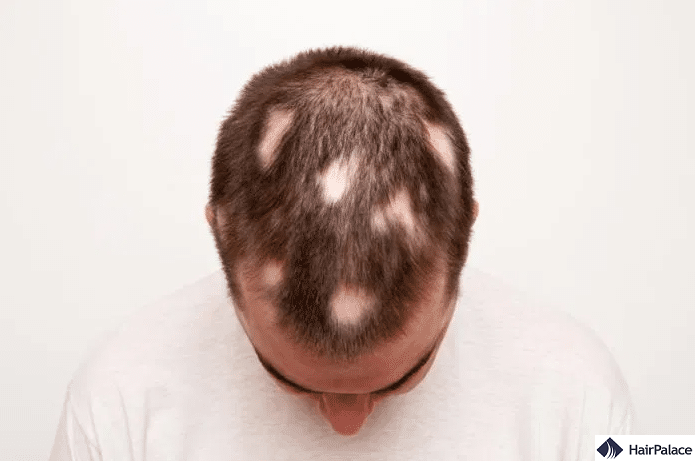Balding: What is it and How to Treat it?

Balding, or hair loss, commonly occurs due to androgenetic alopecia, which is influenced by genetics and the hormone dihydrotestosterone (DHT).
It typically manifests as a receding hairline and thinning at the crown in men, and overall thinning in women.
This can result from genetics, physical trauma, fungal and bacterial infections, or an underlying medical condition.
For these reasons, finding out the root cause of your hair loss is the first step to preventing further loss and restimulating hair to grow back. And we’re here to help.
We’ll explore the signs and symptoms of baldness, highlight a variety of treatments available and suggest simple but effective lifestyle changes to help hair growth.
What is balding?
Balding is a term used to describe excessive and severe hair loss.
While it is a phenomenon that can happen anywhere on the body, it is most common and most noticeable on the scalp.
Though not a scientific term, balding often describes the symptoms and results of hair loss conditions like androgenic alopecia, otherwise known as male or female pattern hair loss.
So how does balding occur in the first place? To better understand hair loss, you must first know how hair grows. There are four key phases to the natural hair growth cycle:
- The Anagen phase is when cells in the hair follicle rapidly divide to create new strands. It’s estimated that 90% of your hair will be in this growing phase, which lasts between 2-8 years.
- The Catagen phase is the transitional phase, which sees hair growth slow down and eventually stop altogether. The hair follicle begins to shrink during this time.
- The Telogen phase is the resting phase of the growth cycle, which can last up to 3 months. Hair neither grows nor falls out, but new hair may develop underneath.
- The Exogen phase is the fourth and final stage. This is when your hair falls out. We stand to lose 50 to 100 hairs every day in this way.
In normal circumstances, the hair follicle will return to the Anagen phase and begin the process anew.
But sometimes, external factors disrupt the growth cycle, causing the follicle to stop producing and reproducing strands of hair.
One of the main culprits of this is the androgen hormone dihydrotestosterone (DHT), which can cause hair follicles to shrink in a process called miniaturization.
When it binds to receptors, it will shrink the follicle to such a degree that it cannot produce or maintain healthy hair.
If you continue to lose hair without creating new strands, baldness occurs.
The symptoms of balding
Generally speaking, balding is a term used to describe androgenic alopecia, and as such, it shares all of its symptoms. These include:
- Hair thinning across the top of your scalp
- For men, their hairline will recede further
- For women, their hair part will widen
What causes balding?
One of the principal causes of hair loss is androgenetic alopecia, known as female pattern baldness in women and male pattern baldness in men.
It is one of the most common conditions worldwide, and it may affect you at any age, even as early as your twenties.
The American Hair Loss Council estimates it makes up 95% of hair loss cases.
Though research is still ongoing as to the origins of balding, haircare specialists say the condition stems from:
- Poor genetics
- Growing older
- High levels of androgens (sex hormones)
Though all symptoms are connected, genetics is the biggest influencing factor for developing androgenetic alopecia.
If you have family members who’ve suffered from the condition, you are more likely to develop It yourself.
This is because your family genes may make you more sensitive and produce more androgens.
As discussed earlier, high levels of these sex hormones, like DHT, can adversely affect hair quality and quantity.
High levels of DHT, for example, will shrink follicles and prevent new hair from emerging.
What is the difference between male and female pattern baldness?
While their root causes may be similar, there are some distinctions to be made between female and male pattern baldness.
For men with this condition, their hairline will no doubt recede, and there will be noticeable thinning on the top of the scalp.
Male pattern baldness may also lead to small hair loss patches or, in extreme cases, complete baldness.
On the other hand, it’s rare for women to experience total hair loss or a receding hairline.
Instead, female pattern baldness results in hair thinning across the entire scalp and a widening in the hair part.
6 Other potential causes of hair loss
It’s important to note that androgenetic alopecia is not the only contributor to hair loss and balding. Below are six other conditions to be aware of:
1. Alopecia areata
If you’ve suffered hair loss in a concentrated area of your scalp, you may have developed alopecia areata.
The good news is that this loss can be temporary and will grow back in a few months.
That said, extreme forms of the condition can lead to extensive baldness, disrupt the hair’s natural growth cycle, and prevent any hair from regrowing back.

2. Traction alopecia
Traction alopecia is when hair falls out because of repeated and severe stress.
Usually, it is a by-product of specific hairstyles, including tight braids, tight ponytails, corn rows, and hair extensions.
Though often a form of temporary hair loss, wearing these hairstyles can, over time, lead to permanent damage to your scalp hair.
3. Toxic alopecia
If you’ve recently recovered from a severe illness and are noticing hair loss, it may result from toxic alopecia.
It is a condition triggered by certain medications, including retinoids, thallium, and cancer treatments.
Conditions like thyroid disease and pregnancy can also activate it, but thankfully, hair loss is often only temporary.
4. Scarring or Cicatricial alopecia
Cicatricial alopecia is an inflammatory condition that destroys hair follicles and replaces them with scar tissue.
These scars can cause extreme, permanent hair loss on your scalp.
Conditions such as lupus, sarcoidosis, tuberculosis, fungal skin infections, and cancers can trigger the condition into action.
5. Telogen effluvium (TE)
Telogen effluvium is a common type of hair loss triggered by high stress and shock levels.
Other life events, like suffering from an illness, an operation, or dramatic weight loss, can also play a part in its development.
Your hair should grow back within two to six months following the event.
6. Tinea capitis
Also known as ringworm, Tinea capitis is a rash caused by a fungal infection. It is easy to diagnose as the condition forms circular lesions in affected areas.
If left untreated, these lesions can lead to scarring and result in permanent hair loss.
As a fungal infection, it is highly contagious and, as such, should be treated as quickly as possible.
Hair loss myths
As well as highlighting common causes of hair loss and balding, we should also dispel several common myths that people think are factors, including:
- Wearing lots of hats or wigs
- Taking creatine
- Poor circulation to the hair and scalp
- Washing your hair often with shampoo
- Dandruff
While the above points will not cause hair loss on their own, do keep an open mind on how they may affect preexisting conditions, and follow the advice of haircare specialists and your doctors accordingly.
5 Treatments for baldness
As distressing as hair loss is, there are ways to help alleviate symptoms and counteract further hair loss.
1. Medications
Various medications are used for the treatment of baldness, these include:
- Minoxidil: When applied directly to the scalp, hair follicles receive a boost in oxygen and nutrients arrive more easily.
- Finasteride: By lowering DHT hormone levels in the body, it is thought the medicine helps prolong the growth of hair follicles and limit shrinking.
- Dutasteride: Like finasteride, it inhibits Type 2 Alpha-reductase enzymes from DHT production. It also works on Type 1 of the enzyme, resulting in a bigger drop in DHT levels.
- Spironolactone: Studies have shown that taking spironolactone can lead to increased hair growth and thicker hair in women.
2. Hormone therapy
If a hormone imbalance is causing your hair loss, then this treatment can be an effective way to improve hair density.
It is beneficial for menopausal women, as it can increase estrogen and progesterone levels.
3. PRP for hair loss
Platelet-rich plasma is an innovative treatment that uses your own platelets in the blood to stimulate hair growth and accelerate healing.
Though still relatively new, PRP has promising results, though continued treatment is required to maintain results.
Once you stop, you will lose hair again.
4. Low-level laser therapy
Another innovative treatment for hair loss is low-level laser therapy.
This light therapy exposes your scalp, improving blood flow and ensuring hair follicles receive all the necessary nourishment.
It can help stimulate new hair growth in men and women and can come in many different devices, including laser caps, for comfort and convenience.
5. Hair transplants
A hair transplant offers a permanent solution to balding.
In just one procedure, a highly-skilled surgeon harvests healthy donor hair from the back and sides of your head and implants them strategically into balding areas or your receding hairline.
FUE hair transplants have transformed the looks of millions worldwide, browse our before and after gallery to see the stunning results for yourself.
Can you prevent baldness?
In some cases, especially if genetics are involved, it can be nigh impossible to prevent hair loss.
That said, there are several things you can do to reduce the risk and minimize loss.
Some simple things to keep in mind include:
- Diet: Your diet dramatically impacts the quality and quantity of your hair. Include foods rich in biotin, iron, zinc, and protein to ensure your hair follicles receive everything they need.
- Physical therapy: Scalp massages can help promote hair growth by improving blood circulation around the scalp. A better blood flow ensures follicles receive oxygen and nutrients.
- Lifestyle choices: Scientific studies have shown there may be a link between smoking and male pattern baldness. As such, we recommend you give up this habit.
- Avoid harsh hairstyles: Certain hairstyles, including braids, cornrows, and tight ponytails, can stress and pull at hair, making them more susceptible to falling out. Avoid these where possible.
- Avoid harsh styling techniques: Some style devices, like hair straighteners and curling irons, can cause massive damage to hair strands and roots.
- Medications: Certain medications we take may have a side effect of hair loss. Consult with your doctor if there are other alternatives you can take.
- Cooling cap: A cool cap can be a way to support your hair if you are undergoing radiation therapy.
Last medically reviewed on July 17th, 2024
- Do you have hair loss or hair shedding? (n.d.).https://www.aad.org/hair-shedding
- Phillips TG, et al. (2017). Hair loss: Common causes and treatment.https://www.aafp.org/afp/2017/0915/p371.html
- Understanding hair loss in men and women. (n.d.).https://www.ahlc.org/understanding-hair-loss-in-men-women/
- Ustuner ET. (2013). Cause of androgenic alopecia: Crux of the matter. https://dx.doi.org/10.1097%2FGOX.0000000000000005


